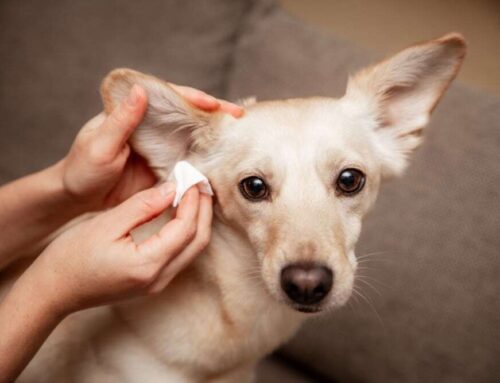Dogs’ and cats’ vision helps them navigate their environment and avoid danger, but many diseases and conditions can affect pets’ eyes. Most eye diseases present similarly, but our Animal Medical Hospital of Naples team can diagnose the problem and create a short- or long-term management plan, depending on the disease’s nature. Read our latest blog post to learn about common eye conditions your four-legged friend could develop.
Eye disease signs in pets
Many eye diseases present with similar signs, and you may have difficulty recognizing which of these indicates a minor problem and which could be a more severe issue. Generally speaking, you should schedule a veterinary visit for your pet if they display the following eye condition signs or changes:
- Redness
- Bulging
- Eyelid or conjunctiva swelling
- Squinting
- Runny or mucoid discharge
- Dark spots, white spots, or divots
- Iris color changes
- Blue or grey cornea color change
- Rubbing or scratching at the eye
- Vision loss
Eye disease causes in pets
Eye diseases are more likely to occur in certain breeds because of genetic and conformational factors, but an eye condition may also seem to occur randomly. Consider pets’ common eye disease causes:
- Genetics — Many eye diseases are common in specific breeds, likely having a genetic underlying basis. Our Animal Medical Hospital of Naples team can perform your pet’s genetic testing to detect a select few of these eye diseases.
- Skull shape — Dogs and cats with rounded skulls, shortened noses, and large, bulging eyes (i.e., brachycephalic) are more likely to develop certain eye conditions.
- Medical history — A cat’s vaccination history and exposure to viral or bacterial diseases can impact their future eye disease development. Dogs and cats can also develop some eye conditions in response to systemic health issues such as cancer, and tick-borne or autoimmune diseases.
- Injury — Trauma can cause an acute eye injury and lead to chronic eye disease or vision loss.
Common eye diseases in pets
Hundreds of diseases can affect pets’ eyes, but a few occur commonly. Consider the most frequently encountered eye issues our team sees in dogs and cats:
- Corneal diseases and injuries — The cornea is a clear window covering the front eye portion (i.e., anterior chamber) and consists of multiple specialized cell layers. The cornea can become inflamed (i.e., keratitis), injured (i.e., corneal ulcer), or filled with fluid (i.e., corneal edema, corneal endothelial dystrophy), obstructing an affected pet’s vision in some cases.
- Dry eye disease — Pets with dry eye disease (i.e., keratoconjunctivitis sicca [KCS]) do not produce enough of the watery tear layer, leaving them with only the mucous tear layer and causing corneal dryness, irritation, ulcers, and chronic scarring.
- Glaucoma — Glaucoma is a problem with eye fluid drainage, which allows pressure to build up and cause pain. Glaucoma is common in dogs and is usually genetic. However, glaucoma can occur secondary to dogs’ and cats’ other eye diseases.
- Eyelid and eyelash disorders —Many pets have eyelid or eyelash disorders. Entropion causes eyelids to roll inward, ectropion causes eyelids to roll outward, distichia are extra eyelashes that rub on the eyes, and ectopic cilia are rogue hairs growing from the eyelid’s underside. Cherry eye is a prolapsed third eyelid gland that appears as a pink or red bump at the inner eye corner.
- Nuclear sclerosis and cataracts — The eye’s lens is the clear structure that sits behind the iris and pupil, helping to focus light on the retina. The lens hardens and becomes slightly cloudy with age (i.e., nuclear sclerosis). Some pets also develop cataracts, a completely opaque area in the lens that obstructs vision.
- Conjunctivitis — Conjunctivae line the eyelids and parts of the eye white (i.e., sclera) and become swollen and red in response to allergies, irritants, infections, or other eye diseases. Feline herpesvirus commonly causes cats’ conjunctivitis.
- Anterior uveitis — Inflammation inside the eye’s front portion (i.e., anterior chamber) can lead to glaucoma or blindness. This inflammation often stems from another underlying illness or immune system problem.
- Retinal disease or detachment — The retina is the tissue lining the back of the eye that detects and processes light, sending signals to the brain for vision. Retinal detachment or degeneration can lead to acute or chronic, painless, and generally untreatable blindness.
Eye disease diagnosis in pets
Diagnosing eye disease accurately may take a few visits, depending on the problem. We can perform a basic eye examination and diagnostic tests that check for ulcers, glaucoma, or dry eyes. Additional tests, including blood, urine, blood pressure, or X-rays, may be helpful if we suspect a systemic disease. If the diagnosis is still unclear after performing appropriate tests, our Animal Medical Hospital of Naples team may refer your pet to a veterinary ophthalmologist.
Eye disease management in pets

Eye disease treatment and management fall into two categories: medical and surgical. Your pet’s recommended treatment type will depend on their condition, the condition’s severity, and your personal preferences. Medical treatments usually include short- or long-term therapy with eye drops or ointments, oral medications, and protective cone collars. Your pet may also need minor in-office procedures.
Surgical treatments aim for a more permanent solution to some eye conditions but may also be combined with long-term medical therapies. Surgery is generally required to treat eyelid and eyelash disorders, cherry eye, severe corneal ulcers, cataracts, and some glaucoma cases. If your pet has blind, painful eyes, we may recommend eye removal surgery.
Eye disorders are common reasons for veterinary clinic visits. Our Animal Medical Hospital of Naples team can handle many routine and minor eye conditions in a low-stress and gentle atmosphere. For advanced or unusual diseases, we may refer your pet to a veterinary ophthalmology specialist. If your pet is exhibiting eye disease signs, or if you have questions regarding your furry pal’s eye disease management plan, contact our team.







Leave A Comment